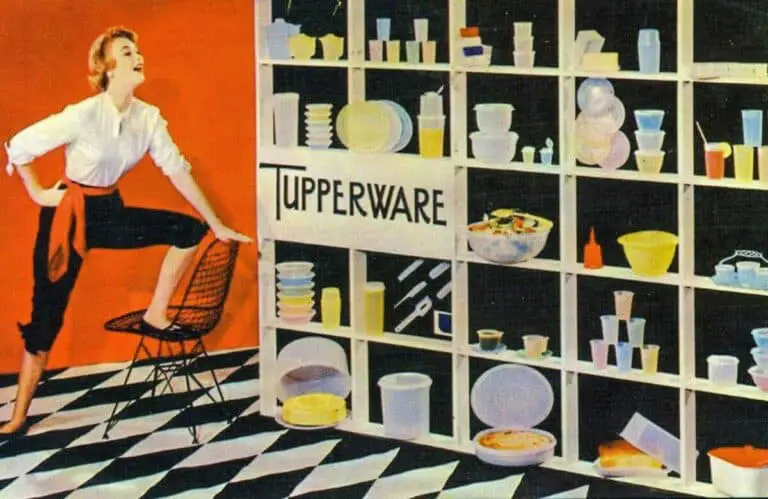In the vibrant world of vintage collectibles, an unsung hero continues to shine – Tupperware, the quintessential plastic container that forever changed the dynamics of domestic life, continues to resonate. Defying the cruel hands of time, these handy boxes retain their charm and utility, finding allies in millennials’ enduring love of all things classic and nostalgic.
Numerous e-commerce platforms and marketplaces dedicated to antiques and vintage items have embraced Tupperware, featuring these beloved containers alongside cherished silverware and trusty Pyrex cookware (another product that has also fallen victim to its success – but that’s another story). But to truly appreciate Tupperware’s relevance today, let’s delve into the brand’s compelling origins, explore the modern market for vintage pieces and demystify their current pricing.
Exploring the Tupperware Revolution
Tupperware, a household name synonymous with versatile and durable plastic containers, has graced kitchens around the world and become an indispensable part of our daily lives. Tupperware’s fascinating journey began with its founder, Earl Silas Tupper, an American innovator who revolutionized kitchen storage. His ingenious design of airtight containers not only preserved food efficiently but also ushered in an era of convenience in food storage and organization.
Known for their practicality and reliability, these eponymous products have become deeply ingrained in the fabric of domestic life and a cultural icon. Tupperware has transcended its functional role, representing a blend of innovation and everyday utility. It’s a testament to its widespread appeal that Tupperware has become a generic term for airtight plastic containers, underscoring its lasting impact on homemaking and food preservation practices worldwide.
The Genesis of Tupperware and Earl Tupper’s Ingenious Innovation
The story of Tupperware unfolds through the visionary efforts of Earl Tupper, an American engineer and chemist whose ingenuity reshaped kitchen storage. While working for Du Pont de Nemours, Tupper explored the possibilities of polyethylene, a then-new and affordable thermoplastic resin that has since become the world’s most widely used plastic. His breakthrough invention was simple yet revolutionary: small, airtight plastic bowls designed to make household chores easier, especially for women.
In 1939, Tupper founded the Tupper Plastics Company in Orlando, Florida, ushering in a new era of food storage. In 1946, he introduced his products to the marketplace and changed the face of the kitchen: The Wonder Bowl. This hermetically sealed container, complete with a flexible lid, was tailor-made for food preservation and perfectly timed with the advent of refrigerators in American homes. Despite its innovative design, the Wonder Bowl’s initial reception was lukewarm, posing a challenge to its market breakthrough. Tupper’s tenacity, however, would soon change the domestic landscape and make Tupperware a household staple worldwide.
The Emergence and Success of the “Tupperware Party” Phenomenon
Tupperware’s trajectory took a remarkable turn in the late 1940s, thanks to an innovative sales approach called the “Tupperware Party. This shift in strategy, initiated in 1948 by Brownie Wise, an astute door-to-door saleswoman, marked the beginning of a unique and highly effective in-home demonstration and sales method. Wise’s vision led her to persuade Earl Tupper to adopt this model, fundamentally changing the company’s approach to marketing.
These in-home parties became the perfect platform for demonstrating Tupperware’s utility to an engaged audience of homemakers. The concept was groundbreaking: a saleswoman would demonstrate Tupperware’s features in an intimate setting, resulting in a rapid and substantial increase in the product’s popularity.
Recognizing the unprecedented success of these gatherings, Tupperware made a bold move in 1951, withdrawing its products from traditional retail outlets to focus exclusively on direct sales through these parties. This strategy not only boosted sales, but also fostered a strong sense of community and customer loyalty. Tupperware further incentivized this model by introducing a rewards system for “hostesses,” offering gifts and benefits based on the sales generated from the events they hosted.
This innovative approach led to a significant expansion of the Tupperware brand. By 1958, the company had grown to a valuation of $16 million, a testament to the effectiveness of the Tupperware Party model. This strategy not only revolutionized Tupperware’s sales, but also became a cultural phenomenon that reshaped the direct selling industry and empowered women in the workforce.
Tupperware: Crafting a Lasting Legacy in Modern Homes
For more than sixty years, Tupperware has remained a household name by continually adapting and maintaining its relevance in an ever-changing marketplace. Far from being just a container for food storage, today’s Tupperware has evolved to meet a variety of kitchen needs. It now helps with heating, microwaving and even serving food, and comes in a range of vibrant colors and designs that appeal to contemporary aesthetics.
The Tupperware product line has diversified considerably. It now includes a wide range of kitchen essentials, including versatile ice cube trays, functional cake pans, convenient baking dishes and more. This expansion reflects the brand’s commitment to innovation and understanding of the needs of the modern kitchen.
By 2003, Tupperware Corporation had established a formidable global presence, operating in more than 100 countries and generating impressive sales of $1.1 billion. This global expansion and financial success underscores Tupperware’s enduring appeal and ability to resonate with consumers around the world. The brand has not only survived, but thrived, creating an indelible legacy in kitchens around the world as a symbol of quality, innovation and reliability in food storage and preparation.
Vintage Tupperware: A thriving market in the age of nostalgia
Amid a vintage revival, particularly among millennials, a thriving secondary market for vintage Tupperware has emerged. This trend is fueled by a desire to recapture the nostalgia of the past and add a unique retro flair to modern kitchens. E-commerce platforms such as eBay and Etsy are at the forefront of this phenomenon, with vintage Tupperware becoming a highly sought-after item among collectors and enthusiasts.
Where to Find Vintage Tupperware
Vintage Tupperware is readily available on major e-commerce sites, especially in the tableware sections. Platforms dedicated to antiques and vintage goods, such as eBay and Etsy, have become hotspots for those looking to add these colorful and nostalgic pieces to their collections. Beyond their utility, vintage Tupperware pieces evoke childhood memories for many, making them more than just functional items. They offer a sustainable option for those who prefer to use plastic containers, with the added appeal of owning something not found in every home.
The value of vintage Tupperware
The value of vintage Tupperware varies greatly depending on factors such as rarity and condition. Some pieces are modestly priced, while others can fetch several hundred dollars due to their scarcity. On Etsy, for example, you can find a wide variety of vintage Tupperware sets, with prices reflecting their vintage value:
- Vintage 1970’s Orange Tupperware Set Of 9 (US$201.08)
- Retro Yellow Tupperware Canisters With Lids And Melon Baller and Egg Yolk Separator (US$173.32)
- Vintage Tupperware Jadeite Collection, Colander, Vegetable Crisper, Lettuce Crisper, and Shredder (US$172.55)
- Vintage Tupperware Slim Decorator Canister Avocado Green – 4.05Litre (US$167.30)
Summing up
The growing fascination with vintage Tupperware highlights a broader trend in the world of collectibles. The prices of these items may seem steep, but their value is inherently tied to the enthusiasm and perceived worth of the collector. More than just kitchenware, vintage Tupperware represents a tangible link to the past, embodying a blend of nostalgia and historical significance. This surge in popularity is a clear indicator of Tupperware’s enduring influence, as items from decades past not only remain relevant, but become treasured collectibles that combine practicality with the distinct charm of another era.
For more than seven decades, Tupperware has been a testament to innovation and an important part of our cultural fabric. Its enduring legacy is evident in the high demand and premium prices of its vintage offerings. Regardless of one’s personal connection to the brand, it is clear that Tupperware, particularly its vintage iterations, will continue to captivate and hold value well into the future.



